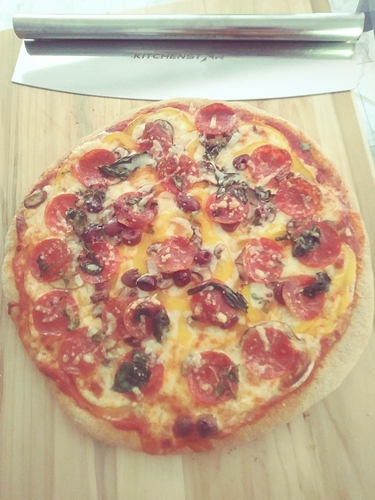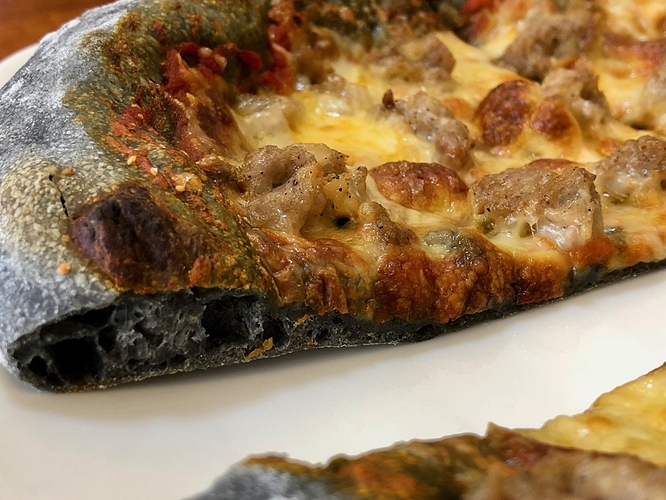Our little 7 year old chose “homemade pizza” for her dinner tomorrow. Earlier experiments turned out pretty lousy- usually soggy and once raw dough on the sides. I’m determined to give the little one pizza https://fastinternational.org/parkway-pizza-evansville/ at home and am going to try again. I did a search of old posts and there are some nice looking recipes but not as many cooking tips. I plan to make the dough tomorrow and my sister cans her own pizza sauce that is very good, so that is not an issue. Main issue is how to keep the pizza from getting soggy when using a conventional oven. Please fire away! Thanks.
Secret to a good pizza base is a long ferment. Doesn’t have to be anything too complicated. A simple white high(ish) hydration dough with some olive oil and a touch of sugar (optional). Use a small amount of yeast for an all night ferment. Next morning portion it out and preshape into a ball, rest till relaxed (the dough - and you  ) then using your hands fashion out a base. If not ready to use you can refrigerate the balls of dough. Or aim for an early morning start to be ready by evening.
) then using your hands fashion out a base. If not ready to use you can refrigerate the balls of dough. Or aim for an early morning start to be ready by evening.
If you’re having trouble with a soggy bottom (the dough only this time) then after you’ve made the base prick the the dough using a fork leaving the outer rim untouch. Then par bake it for 5 minutes, remove from oven and put all the ingredients on top then back into the oven to finish off.
I make a whole grain dough using three different grains but does not have to be, with a hydration rate of 66% (sometimes add another teaspoon of water, normally use instant yeast but have used sourdough starter with success. Make 24 hours in advance and refrigerate the formed dough balls to ferment. Next day warm to room temperature, spread by hand to desired size and bake on a pizza stone either in the house in the oven or in the grill on the patio. In my 2 pizzeria’s I made the standard pizza dough from bread flour, we removed from the cooler and spread on pizza pans which of course had a stone floor in the oven. At home it is a little more challenging but fun once you get the hang of it.
Your home oven needs to be as hot as you can get it. I set mine for 550F and wait until the stone is pushing 500F before setting the entire pie. My crust is about 1/4" thick on the bottom and it comes out with a crunch when slicing through it, the dough itself is cooked through with all the little holes. Generally it takes about 5 minutes give or take a bit to brown the cheese on top and have the crust cook properly. Trust me 100 degrees makes a big difference so get an instant read thermometer.
Don’t do the “American Thing” and pile the toppings high. SOMETIMES less is better. Mine is about max as you can see in the pictures. The more on the top the longer it takes to cook through and you can get a soggy crust from this. Be wary of fresh vegetables that have water in them.
DO: Set sliced tomatoes, onions, peppers, olives etc. on paper towels to remove some of the moisture. AVOID extra water.
DO: Spray olive oil lightly across the top of the dough before placing sauce and other ingredients. I use my hand to lightly smooth around to cover all but the edges. This will keep the sauce from penetrating the dough.
I am used to a brick oven from the restaurants but tried different other options at home. Have different pans, some with holes, tried baking on the wire shelves (never could get the bottom heat where I wanted it) and found the baking stones to be the ticket. Personally I would not dock (prick) the dough (don’t want moisture to migrate to the bottom) unless you are going to pre-bake the dough but that is really not necessary. The stones or steels can be used to bake some breads directly on the stone and other food items also.
I have recipes for dough and sauce if anyone is interested just send an email. Pie pictured is 12" more than enough for 2.
I attached a before and after from last Friday night.
Hope this answers a few questions.
- I use a fairly typical sourdough bread recipe at only 67% hydration and a tablespoon or two of EVOO (depending on how much dough I am making). I worry less about over proofing pizza dough than regular bread dough.
- Agree on suggestions above, get your oven as hot as you possibly can and give your pizza stone enough time to come to temperature fully.
- Place the pizza stone close to the top of your oven. I even turn the broiler on while cooking because there is nothing sadder than a pale pizza crust.
- Probably too late, but if you make pizza often, consider buying a Baking Steel. It is magical for getting a crisp crust and orders of magnitude better than a pizza stone.
- Again, as stated above, do not put too many wet items on the dough (use half the pizza sauce you think you need, try shredded mozzarella rather than fresh mozzarella, add some shredded parmesan (it will give you the caramelization better than the mozzarella), microwave pepperoni before cooking (and dab off the oil that otherwise ends up on the pizza), and slice tomatoes very thin if you are putting any on top). The more toppings you use, the harder it will be to get a crisp crust. Not impossible but harder to get right.
- Make sure you sister’s sauce is pizza sauce and not marinara sauce. Pizza sauce should be much thicker.
- Unless you are using a lot of parmesan cheese (or pepperoni, bacon, etc.), consider sprinkling a pinch of salt over your pizza before baking.
I don’t think your comments or mine are too late as I hope it emphasizes the requirement for some trial and error in the OP’s kitchen and not to expect the first few to come out perfect. I made the MISTAKE of inviting friends over for my first and it wound up being embarrassing.
Sometimes things happen and the pie doesn’t turn out like all the others. There is that all time saying “S___t happens.” Before I went into the pizza business I asked a friend that had a shop for 20 years if every pizza left his place “PERFECT?” His answer was “sometimes no but don’t worry about it as your customer will come back for that perfect one they had before.” Not sure on a personal level I agree with that but the point is to allow for some error, ESPECIALLY at home.
Example of Trial and Error: if I was to place my rack in the top of my oven the bottom would not cook right and the top would brown very quickly. Never tried the broiler though but the pie is only in the oven a few minutes anyways (max 6 minutes). On the grill I had to raise up the center portion of the grill to set the stone on to lessen the heat and sometimes I even turn the center burner off or down to low-low. Don’t know why from bake to bake it can be different but that is where the visual thing comes in when looking at the top and bottom of the pie while baking. The OP needs to start somewhere and keep some notes as to what happened. Then make some changes the next time.
I have no guess as to how many pizzas I made in the shops using commercial ovens, commercial mixer and proof cabinet so I thought I was a REAL EXPERT. With that said…
I decided to make whole grain pizza dough at home not out of the traditional flour used but home finely milled. I do have a proof box and a dedicated retarder where temperatures can be changed but still use the regular refrigerator temps (40F) for the pizza dough as we did in the shops. 24hrs @40F work out just right as the dough is bulging at that point. My first using Einkorn was a disaster (did not realize the dough needed to be spread on parchment at the time.) Then I changed to other varieties and settled on a combination to work with. The whole grain dough is different, and it probably took 4 or 5 tries and tweaks to get it right (mostly.) The pies were all eatable but not what I considered good pizza crust (crispy layer and a chewy light dough). With that said the little lady each week says “this is the best yet.” I’ll keep on practicing …
I don’t think I’ll ever be able to get the large holes in the crust like you have (although I keep playing each week) as almost ALL of my breads and pizza are whole grain and you have to make an allowance for that.
BTW: I found through trial and error at home to turn the pizza 15 degrees every 2 minutes and I don’t get any charring of the outer crust. This again depends on your oven. Especially important on the grill here not as bad in my oven but still do it anyways. OP needs to invest in a peel to make this easy. Of course makes getting the pie on the steel/stone easier also.
Eric from Breadtopia sells a Super Peel which has a sliding cloth attached and mimics the commercial table found in bakeries. It works well by working some flour into the fabric and then sprinkling corn meal or coarse semolina before placing the dough. Takes a little practice to use but we use it for pizza, breads etc. Of course a metal peel is needed to turn the pie easily and get off the stone.



